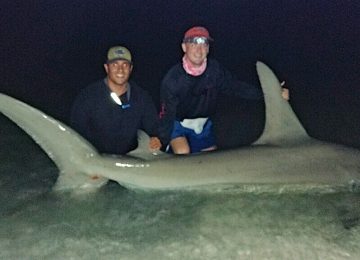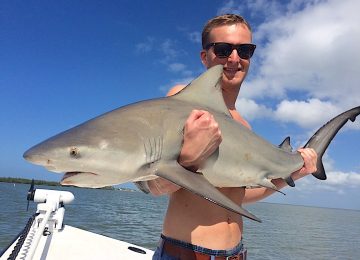Sanibel Fishing Charters, February 12, 2021: Sandbar Shark, Catch & Release!
Red Tide/Algae & Daily Salt Water Quality Update Here.
Blue-Green Algae & Daily Fresh Water Quality Update Here.
Captiva Fishing: Please Click For Rates & To Book A Captiva Fishing Charter Or Call 239-472-8658.




Sanibel Island Fishing Charters, February 12, 2021
Please Click To Rent Homes Direct From Captiva Homeowners; No VRBO Booking Fees.

Vote Water For Florida’s Future!
Captiva Fishing Guide Report: February, 12: Sandbar Shark, Catch & Release, Captain Joe’s Charters – a lot of sharks and good fish have moved back into the gulf, bay, and passes; redfish, sheepshead, black drum, snapper, snook, and seatrout are currently present.
Redfish & snook are regulated as catch & release at this time.
Already seeing some positive impact. Some very nice big redfish and snook around, more big redfish than snook.
The Caloosahatchee freshwater releases are also not an issue right now, but still a huge long-term problem.
Extremely frustrating. We need wholesale changes in the Florida state government. It is not a Republican or Democrat issue – it is a Big Sugar control everyone issue. It is stunning how we continue to let the sugar industry and the agriculture north of Lake Okeechobee to damage the water and all of Florida.
Please click here to Book A Charter or call 239-472-8658.
We’re located in Castaways Marina, Santiva, Sanibel Island, just before the Blind Pass bridge to Captiva Island.
Turner Beach, the beach adjoining Blind Pass, is frequently covered with a bounty of shells from Olives to Fighting Whelks to the more common Conchs.
The fishing is also renowned for sharks in the summer, tailing redfish on the bayside flats and snook under and off the Blind Pass bridge. Because Turner Beach faces Westward, the sunsets are spectacular and a popular viewing point for residents and visitors alike.

“The sandbar shark (Carcharhinus plumbeus) is a species of requiem shark, and part of the family Carcharhinidae, native to the Atlantic Ocean and the Indo-Pacific. It is distinguishable by its very high first dorsal fin and inter-dorsal ridge.[2] It is not to be confused with its similarly named shark cousin, the sand tiger shark, Carcharius taurus.[19]”

The sandbar shark is also called the thick skin shark or brown shark. It is one of the biggest coastal sharks in the world and is closely related to the dusky shark, the bignose shark, and the bull shark. Its dorsal fin is triangular and very high and it has very long pectoral fins. Sandbar sharks usually have heavy-set bodies and rounded snouts that are shorter than the average shark’s snout.

Their upper teeth have broadly uneven cusps with sharp edges. Its second dorsal fin and anal fin are close to the same height. Females reach sexual maturity around the age of 13 with an average fork-length (tip of the nose to fork in the tail) of 154.9 cm, while males tend to reach maturity around age 12 with an average fork-length of 151.6 cm.[3] Females can grow to 2–2.5 m (6.6–8.2 ft), males up to 1.8 m (5.9 ft). Its body color can vary from a bluish to a brownish grey to bronze, with a white or pale underside. Sandbar sharks swim alone or gather in sex-segregated schools that vary in size.

The sandbar shark, true to its nickname, is commonly found over muddy or sandy bottoms in shallow coastal waters such as bays, estuaries, harbors, or the mouths of rivers, but it also swims in deeper waters (200 m or more) as well as intertidal zones. Sandbar sharks are found in tropical to temperate waters worldwide; in the western Atlantic, they range from Massachusetts to Brazil.

Juveniles are common to abundant in the lower Chesapeake Bay, and nursery grounds are found from Delaware Bay to South Carolina. Other nursery grounds include Boncuk Bay in Marmaris, Muğla/Turkey[4] and the Florida Keys.[3]
Natural predators of the sandbar shark include the tiger shark and rarely great white sharks. The sandbar shark itself preys on fish, rays, and crabs.

Sandbar sharks are viviparous. The embryos are supported in placental yolk sac inside the mother. Females have been found to exhibit both biennial and triennial reproductive cycles, ovulate in early summer, and give birth to an average of 8 pups, which they carry for 1 year before giving birth.[3] The longevity of the sandbar shark is typically 35–41 years.[5]

Sandbar sharks have been disproportionately targeted by the U.S. commercial shark fisheries in recent decades due to their high fin-to-body weight ratio, and U.S. fishing regulation requiring carcasses to be landed along with shark fins. In 2008, the National Marine Fisheries Service banned all commercial landings of sandbar sharks based on a 2006 stock assessment by SEDAR, and sandbar sharks were listed as vulnerable, due to overfishing.
Currently, there are a small number of specially permitted vessels fishing for sandbars sharks for the purpose of scientific research. All vessels in the research fishery are required to carry an independent researcher while targeting sandbars.[3]

In spite of their large size and similar appearance to other dangerous sharks like Bull Sharks, there are very few, if any attacks attributed to sandbar sharks and so they are considered not to be dangerous to people. As a result, they are considered one of the safest sharks to swim with and are popular sharks for aquariums.” Please see more information here.

Sandbar Shark Summary
- Snout broadly rounded and short
- The first dorsal fin is large and triangular, begins over or in front of pectoral fin insertion
- Back is brown or gray, fading to a white belly
- Interdorsal ridge present
Similar Species: Dusky shark, C. obscurus (first dorsal starts over pectoral fin free tip); bull shark, C. leucas (no interdorsal ridge)
Size: Up to 8 feet
Coastal and offshore waters, typically found at depths ranging from 60 to 200 feet. May enter estuaries.
Predators and scavengers. Feeding occurs chiefly near the bottom on fish and shellfish. Migrate long distances and they mature at about 6 feet in length.
Florida State Record: This species is not currently eligible for a state record.
Recreational Regulations” Please see more information here.

Please click here to Book A Charter or call 239-472-8658.
We’re located in Castaways Marina, Santiva, Sanibel Island, just before the Blind Pass bridge to Captiva Island.

After a fierce storm, Turner Beach, the beach adjoining the Pass, is frequently covered with a bounty of shells from Olives to Fighting Whelks to the more common Conchs. The fishing is also renowned for sharks in the summer, tailing redfish on the bayside flats and snook under and off the Blind Pass bridge. Because Turner Beach faces Westward, the sunsets are spectacular and a popular viewing point for residents and visitors alike.

Please like us on Facebook!
Fair winds and following seas,
Captain Joey Burnsed ~ please click calendar or call 239-472-8658 to book a Sanibel & Captiva Islands, Boca Grande or Fort Myers fishing guide trip or shelling charter.

![Hogfish or Hog Snapper, Sanibel Fishing & Captiva Fishing, Sanibel Island, Sunday, December 10, 2017, [File Photo - Wednesday, February 8, 2017].](https://captivafishing.net/wp-content/uploads/wordpress-popular-posts/13104-featured-360x260.jpg)

![Hogfish or Hog Snapper, Sanibel Fishing & Captiva Fishing, Sanibel Island, Sunday, December 10, 2017, [File Photo - Wednesday, February 8, 2017].](https://captivafishing.net/wp-content/uploads/wordpress-popular-posts/11558-featured-360x260.jpg)







![Goliath grouper, Sanibel & Captiva Islands & Fort Myers Charters & Fishing Guide Service, Thursday, November 2, 2017, [August 16, 2012].](https://captivafishing.net/wp-content/uploads/wordpress-popular-posts/11711-featured-360x260.jpg)



![Hogfish or Hog Snapper, Sanibel Fishing & Captiva Fishing, Sanibel Island, Sunday, December 10, 2017, [File Photo - Wednesday, February 8, 2017].](https://captivafishing.net/wp-content/uploads/wordpress-popular-posts/11143-featured-360x260.jpg)





![Schoolmaster Snapper, Sanibel Fishing & Captiva Fishing, Sanibel Island, Thursday, January 11, 2018, [File Photo - Thursday, December 28, 2017].](https://captivafishing.net/wp-content/uploads/wordpress-popular-posts/13203-featured-360x260.jpg)





















You must be logged in to post a comment.